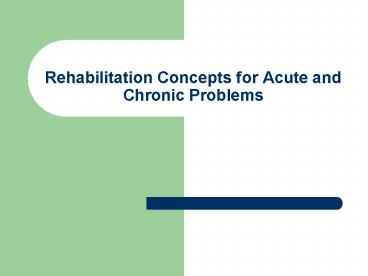Rehabilitation Concepts for Acute and Chronic Problems - PowerPoint PPT Presentation
1 / 24
Title:
Rehabilitation Concepts for Acute and Chronic Problems
Description:
... impairment, sensory-perceptual impairment, pain, activity intolerance, fatigue ... maximum physical mobility possible with the least restriction of activity ... – PowerPoint PPT presentation
Number of Views:119
Avg rating:3.0/5.0
Title: Rehabilitation Concepts for Acute and Chronic Problems
1
Rehabilitation Concepts for Acute and Chronic
Problems
2
Definitions
- Chronic Illness or condition has existed for at
least 3 months. - Disabling condition any physical for mental
health problem that can cause disability. - Rehabilitation process of learning to live with
chronic and disabling conditions
3
Definitions (continued)
- Impairment an abnormality of a body structure or
structures or an alteration in a body system
function resulting from any cause represents a
disturbance at the organ level - Disability consequence of an impairment and is
usually described in terms of clients altered
functional ability - Handicap the disadvantage experienced by a
person as a result of impairments and
disabilities represents a disturbance at the
societal level
4
Rehabilitation Goal
- To return the client to fullest possible
physical, mental, social, vocational, and
economic capacity.
5
Rehab A Team Approach
- Successful rehabilitation depends upon the
coordinated effort of health care professionals,
interdisciplinary rehabilitation team, and
involvement of the client, family and other
support systems.
6
Rehabilitation Team Goals
- Prevention of injury
- Restoration of function
7
Focused Assessment Of Rehabilitation Clients
- Cardiovascular system
- Respiratory system
- Gastrointestinal system and nutrition
- Renal-urinary system
- Neurologic system
- Musculoskeletal system
- Integumentary system
- (see Table 10-1,
p. 121)
8
Additional Assessment Areas
- Functional Assessment
- Psychosocial Assessment
- Vocational Assessment
9
Common Nursing Diagnoses
- Impaired physical mobility r/t neuromuscular
impairment, sensory-perceptual impairment, pain,
activity intolerance, fatigue or the effects of
trauma or surgery. - Self-care deficit (Total or Partial) r/t effects
of trauma or chronic illness, muscular weakness,
pain, immobility, or perceptual-cognitive
impairment.
10
Nursing Diagnoses (Cont.)
- Risk for Impaired Skin Integrity r/t altered
sensation or mobility. - Impaired Urinary Elimination r/t sensorimotor
impairment or immobility. - Constipation r/t neuromuscular or musculoskeletal
impairment or immobility. - Ineffective Coping r/t effects of chronic
illness, loss of control over body part or a body
function, or major changes in lifestyle.
11
Impaired Physical Mobility
- Expected Outcome
- (1) achieve the maximum physical mobility
possible with the least restriction of activity - (2) avoid consequences resulting from immobility
12
Impaired Physical Mobility
- Interventions
- Transfer techniques
- Alternative transfer techniques
- Gait training (review Chart 10-2, p. 125)
- Anticipating potential problems with transfers
- Preventing complications of immobility
13
Self-Care Deficit
- Expected Outcome
- to become independent in ADLs to the extent
possible based on his/her disability.
14
Self-Care Deficit
- Interventions
- Encouraging client to perform as much of their
self-care as possible - Offering emotional support
- Using assistive/adaptive devices
- Energy conservation
15
Risk for Impaired Skin Integrity
- Expected Outcome
- to have intact skin
16
Impaired Skin Integrity
- Interventions
- Turning and repositioning
- Skin care
- Nutrition
- Mechanical devices
17
Impaired Urinary Elimination
- Expected Outcome
- (1) achieve a personally acceptable form or
urinary elimination - (2) be free from urinary complications
18
Classification of Bladder Dysfunction
- Reflex or spastic (upper motor neuron) bladder
causes incontinence that is characterized by
sudden, gushing voids. - Flaccid (lower motor neuron) bladder results in
urinary retention and overflow (dribbling) - Uninhibited bladder result of neurologic
problem, little sensorimotor control and cannot
wait until on commode or bedpan before voiding.
Bladder may not completely empty.
19
Impaired Urinary Elimination
- Interventions
- Bladder Training
- Facilitating triggering techniques
- Intermittent catheterization (clean technique)
- Toileting schedule
- Drug Therapy
- Fluid Intake
- Prevention of Complications
20
Constipation
- Expected Outcome
- to achieve a personally acceptable form of bowel
elimination and be free from bowel elimination
complications
21
Constipation
- Interventions
- Bowel Training
- Drug Therapy
- Nutrition
- Prevention of Complications
22
Ineffective Coping
- Expected Outcome
- to learn to cope with the chronic illness or
disability and participate in the rehabilitation
program.
23
Ineffective Coping
- Interventions
- Encourage client to discuss feelings
- Assess clients acceptance of and ability to cope
with the disability - Assess for role changes and need for vocational
training - Assess for socialization problems and assist with
re-socialization. - Assess previous coping strategies, incorporating
successful strategies and assisting client to
change unsuccessful ones.
24
Remember
- Discharge planning begins at admission!!!
- Health teaching needs must be assessed and
addressed.































